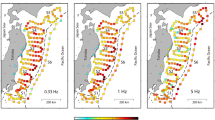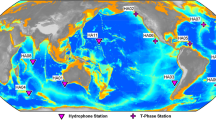Abstract
— Understanding the nature of the coupling between the underwater acoustic field and the land seismic field is important for evaluating the performance of the T-phase stations in the International Monitoring System for the Comprehensive Nuclear-Test-Ban Treaty. For upslope propagation in an ocean environment, the places where underwater acoustic field energy couples into the land seismic field are determined to first approximation by the local water depth and the normal mode composition of the acoustic energy. Therefore, the use of earthquake-generated T phases as natural probes of water-to-land coupling characteristics is aided by knowledge of their modal composition. Data collected by a 200-element, 3000-m-aperture vertical hydrophone array during a 1989 experiment in the deep northeast Pacific Ocean are used to determine the mode composition of T-phase arrivals from two mb 4.1 earthquakes near the w est coast of the U.S., one occurring offshore and the other on land. Results from an eigenanalysis approach and conventional mode decomposition for the two events are consistent and show that at 5 Hz, the offshore event's arrivals have higher-order mode content compared to those from the event on land. Single hydrophone recordings at Pt. Sur of two mb 4.4 Hawaiian events in 1996 and 1997, one occurring offshore and the second on land, display time-frequency arrival structures that are explainable by the dispersion characteristics over the oceanic path. Although other effects due to complex source time functions and shear wave and dispersive propagation effects along the initial land path cannot be separated with these single element data, differences in these two events' arrival structures suggest differences in normal mode content consistent with those seen in the pair of 1989 events. Ocean-path dispersion also appears to play a significant role in determining the i n-water arrival structure from a 1995 French nuclear test at Mururoa. Recordings of two Hawaiian events in 1997 by the T-phase station VIB and the seismic station at Berkeley illustrate that the water-land coupling confuses the relative timing between normal modes, resulting in apparent loss of information about the source.
Similar content being viewed by others
Author information
Authors and Affiliations
Additional information
(Received June 20, 1999, revised April 4, 2000, accepted April 5, 2000)
Rights and permissions
About this article
Cite this article
D'Spain, G., Berger, L., Kuperman, W. et al. Normal Mode Composition of Earthquake T Phases. Pure appl. geophys. 158, 475–512 (2001). https://doi.org/10.1007/PL00001192
Issue Date:
DOI: https://doi.org/10.1007/PL00001192




